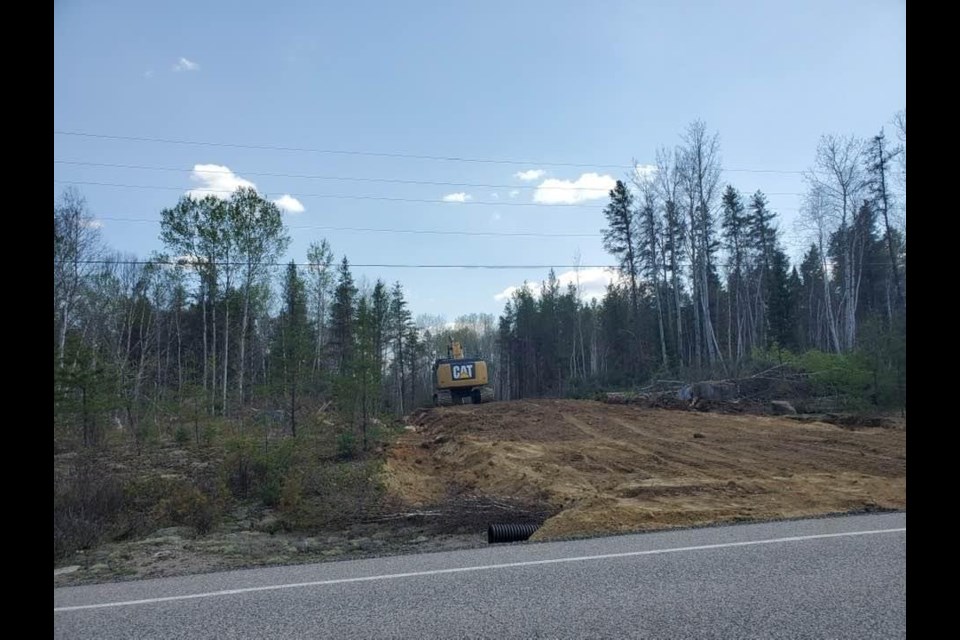Mattagami First Nation member Dorothy Naveau is concerned the province’s activities in the Timiskaming Forest are taking place too close to home.
The forest operations are being done as part of the Ministry of Natural Resources and Forestry’s (MNRF) annual work schedule.
In Ontario, forestry activities in Crown (public) forests include harvesting, building roads and bridges for access, forest renewal, maintenance and planning. Before an activity takes place, the province prepares forest management plans (FMP) that are approved for a 10-year period.
Naveau said she’s not asking the ministry to stop cutting completely but she wants it to stop being so close to the community. According to Naveau, the cutting is happening about five or six kilometres away from the reserve.
Along with two other community members, Naveau visited the site Wednesday, May 19, to see the exact locations of the cut and to leave a hand-written sign stating the cutting needs to stop. She was planning to return to the site the following day as well.
"It’s like beating your head on the wall, practically getting nowhere,” she said.
The current 2021-2031 forest management plan and the 2021-2022 annual work schedule (AWS) for Timiskaming Forest were approved April 1, 2021, according to the ministry's spokesperson Karen Passmore.
"The operational work that is underway by the forest company includes a road that will lead to a harvest block as part of the approved 2021-2031 Timiskaming FMP and associated 2021-22 AWS. The block will be approximately six kilometres away from the reserve," she said in an email.
The FMP states First Nation and Métis communities continue to have concerns regarding their involvement in the forest management planning process. Several First Nation communities have also expressed concerns regarding harvesting in the vicinity of their reserves, according to the plan.
"The issues range from inadequate funding and expertise to participate in the FMP process to concerns regarding the lack of economic benefits that could be available to First Nation and Métis communities," reads the plan. "Many of the issues identified are land-claim based and therefore beyond the scope of a forest management plan."
The plan also mentions that several meetings with various representatives, including from Indigenous communities, were held in 2019 and an Indigenous Task Team was established to increase the participation of First Nation and Métis communities in the FMP process.
Passmore said the ministry worked with Mattagami First Nation and other members of the planning team for three years to develop the plan.
"The MNRF takes its duty to consult with Indigenous people very seriously. All forestry activities in the Timiskaming Forest Management Unit were subject to rigorous planning and extensive consultation," she said. "The MNRF maintains regular communications and continues to be open to further discussions with the forestry company and Mattagami First Nation."
Naveau said she attended meetings and consultations before the pandemic hit to voice her concerns and call for a minimum 25-kilometre buffer zone around the reserve.
"That’s just for building the road, next comes even more cutting which will destroy even more traditional medicines, it will destroy the fish bed and not to mention the wildlife that will be scared away," she said. "Many of us are re-learning our culture, teaching our youth and anyone who wants to learn these valuable teachings. Connecting with the land is paramount in our healing. The government needs to honour our space and let us do this in peace."
The province's annual work schedules, plans and reports are available for viewing online. For Naveau, posting online links doesn’t provide the required information and many community members don’t have access to the internet. There are also pandemic restrictions within the reserve preventing members from leaving the community for long periods of time.
“They’re forever taking advantage of us and this time, it’s due to the pandemic. I’m talking about the government,” she said. “You don’t do that to a population that relies on the land for sustainability. It’s our most reliable source for our medicine, our berries, wildlife. Cutting our land is destroying any of that.”
Mattagami Chief Chad Boissoneau said there are many barriers that need to be addressed and recommendations that must be considered when it comes to First Nations’ historical connection to the land.
“The duty to consult which is regulated by the government needs to be reviewed and evaluated for effectiveness,” he said in an email. “Our people feel like our concerns are falling on deaf ears over and over again.”



